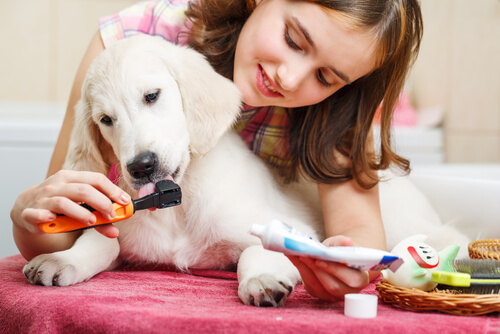How to Give Your Dog White Teeth

Oral problems in dogs are serious, as they cause them a lot of distress and affect their daily lives. Therefore, trying to give your dog white teeth isn’t only a matter of aesthetics, but is directly related to their welfare.
Achieving this goal depends on daily care throughout the animal’s life. That’s why we’ve prepared this article for you in which you’ll find tips to keep your canine friend’s teeth in the best possible condition. Don’t miss it!
What color are a dog’s teeth?
First of all, the first thing you should know is that dogs, like humans and many other animals, don’t have bright white teeth. However, when a dog does have white teeth, it show’s that they’re healthy.
Having said that, it’s normal to see a yellowish coloration in their teeth. This doesn’t necessarily indicate that they have tartar or poor oral health, but is, rather, a natural consequence of the passage of time.
Puppies have very white teeth and it’s normal for them to keep them that way until they’re about 3 years old.
However, it’s useful to know what signs could indicate that your dog has an oral health problem. We’ll highlight them in the following section.

How to recognize oral problems in dogs
The signs that your dog could be suffering from some pathology related to their teeth (or their mouth in general) are clear. The first one is that the teeth will have a yellowish, orange, or brownish color due to tartar. In addition to this, you’ll find the following signs:
- The tartar itself accumulates in the part of the tooth that sticks to the gum.
- Receding gums. As tartar consumes the tissue, the gums recede until the roots of the teeth are exposed.
- Chipped or cracked teeth.
- Swollen, red or bleeding gums. Like the above, gingivitis usually gives this appearance to the gums.
- Bad breath (fruity, urine odor, etc.).
- Teeth that move.
- A pale or warty tongue.
How to give your dog white teeth
If you want your dog to have a healthy and beautiful canine smile, there are several strategies you can implement. Many of them can be combined, so don’t miss them.
Give them a good diet
This is the most basic advice and the one you should always carry out. Proper nutrition prevents all kinds of diseases, including oral diseases. If your dog is prone to tartar build-up, there are also dental foods that are more abrasive than normal and these will help delay the formation of plaque.
Brush your dog’s teeth
Daily brushing is a very effective routine to keep your dog’s teeth white. Be sure to use a toothpaste that’s specific for their species and, if possible, enzymatic.
There are many types of toothbrushes, but if your dog doesn’t like them, then you can resort to other objects, such as thimbles to clean them with your fingers, chew toys that allow you to put the toothpaste on them, etc.
Provide them with dental snacks
Dental treats usually come in the form of dental sticks and other formats that try to prevent the dog from swallowing them whole and having to chew them. Choose those that are the right size for your dog and have a composition that’s actually beneficial to their dental health.
Use rinses and sprays
Some dogs don’t tolerate brushing well, especially those that aren’t used to it from puppyhood. For them there are other options, such as dental sprays or mouthwashes. These are easy to apply and more comfortable for dogs that already have some condition that causes them pain.
These products help prevent the formation of tartar (although they don’t eliminate it) and improve the dog’s breath.
The importance of the veterinarian

Finally, always remember that the best advice you’ll find here to ensure that your dog has healthy white teeth are regular check-ups with your trusted veterinarian. In consultation they’ll advise you on what’s best for the specific case of your dog.
In addition, it’s good that, every so often, you ask for a dental cleaning. In this procedure, the animal is sedated and all tartar plaque is removed by filing the enamel.
In any case, remember that the natural color of a dog’s teeth isn’t bright white, but will have certain yellowish tones from around 3 years of age. Even so, a healthy mouth is easy to identify, and that means you’re doing things right.
Oral problems in dogs are serious, as they cause them a lot of distress and affect their daily lives. Therefore, trying to give your dog white teeth isn’t only a matter of aesthetics, but is directly related to their welfare.
Achieving this goal depends on daily care throughout the animal’s life. That’s why we’ve prepared this article for you in which you’ll find tips to keep your canine friend’s teeth in the best possible condition. Don’t miss it!
What color are a dog’s teeth?
First of all, the first thing you should know is that dogs, like humans and many other animals, don’t have bright white teeth. However, when a dog does have white teeth, it show’s that they’re healthy.
Having said that, it’s normal to see a yellowish coloration in their teeth. This doesn’t necessarily indicate that they have tartar or poor oral health, but is, rather, a natural consequence of the passage of time.
Puppies have very white teeth and it’s normal for them to keep them that way until they’re about 3 years old.
However, it’s useful to know what signs could indicate that your dog has an oral health problem. We’ll highlight them in the following section.

How to recognize oral problems in dogs
The signs that your dog could be suffering from some pathology related to their teeth (or their mouth in general) are clear. The first one is that the teeth will have a yellowish, orange, or brownish color due to tartar. In addition to this, you’ll find the following signs:
- The tartar itself accumulates in the part of the tooth that sticks to the gum.
- Receding gums. As tartar consumes the tissue, the gums recede until the roots of the teeth are exposed.
- Chipped or cracked teeth.
- Swollen, red or bleeding gums. Like the above, gingivitis usually gives this appearance to the gums.
- Bad breath (fruity, urine odor, etc.).
- Teeth that move.
- A pale or warty tongue.
How to give your dog white teeth
If you want your dog to have a healthy and beautiful canine smile, there are several strategies you can implement. Many of them can be combined, so don’t miss them.
Give them a good diet
This is the most basic advice and the one you should always carry out. Proper nutrition prevents all kinds of diseases, including oral diseases. If your dog is prone to tartar build-up, there are also dental foods that are more abrasive than normal and these will help delay the formation of plaque.
Brush your dog’s teeth
Daily brushing is a very effective routine to keep your dog’s teeth white. Be sure to use a toothpaste that’s specific for their species and, if possible, enzymatic.
There are many types of toothbrushes, but if your dog doesn’t like them, then you can resort to other objects, such as thimbles to clean them with your fingers, chew toys that allow you to put the toothpaste on them, etc.
Provide them with dental snacks
Dental treats usually come in the form of dental sticks and other formats that try to prevent the dog from swallowing them whole and having to chew them. Choose those that are the right size for your dog and have a composition that’s actually beneficial to their dental health.
Use rinses and sprays
Some dogs don’t tolerate brushing well, especially those that aren’t used to it from puppyhood. For them there are other options, such as dental sprays or mouthwashes. These are easy to apply and more comfortable for dogs that already have some condition that causes them pain.
These products help prevent the formation of tartar (although they don’t eliminate it) and improve the dog’s breath.
The importance of the veterinarian

Finally, always remember that the best advice you’ll find here to ensure that your dog has healthy white teeth are regular check-ups with your trusted veterinarian. In consultation they’ll advise you on what’s best for the specific case of your dog.
In addition, it’s good that, every so often, you ask for a dental cleaning. In this procedure, the animal is sedated and all tartar plaque is removed by filing the enamel.
In any case, remember that the natural color of a dog’s teeth isn’t bright white, but will have certain yellowish tones from around 3 years of age. Even so, a healthy mouth is easy to identify, and that means you’re doing things right.
All cited sources were thoroughly reviewed by our team to ensure their quality, reliability, currency, and validity. The bibliography of this article was considered reliable and of academic or scientific accuracy.
- Hennet, P. (2006). Nutrición y salud oral en el perro. Enciclopedia de la Nutrición Clínica Canina; Pibot, P., Biourge, V., Elliot, DA, Eds, 413-418.
- Pet Dental Care. (s. f.). Best Friends Animal Society. Recuperado 13 de julio de 2022, de https://resources.bestfriends.org/article/pet-dental-care
This text is provided for informational purposes only and does not replace consultation with a professional. If in doubt, consult your specialist.








